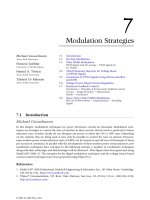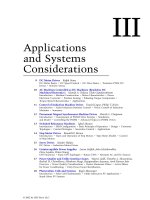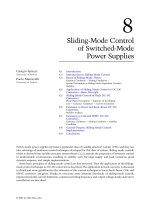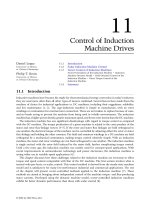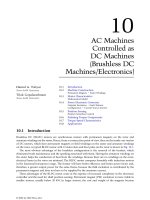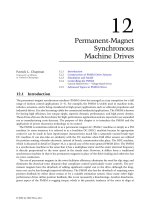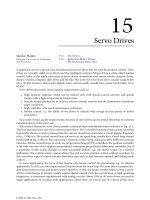mazda, f. (1997). power electronics handbook (3rd ed.)
Bạn đang xem bản rút gọn của tài liệu. Xem và tải ngay bản đầy đủ của tài liệu tại đây (15.62 MB, 450 trang )
'II
-1
1.
I
mon
Mazda
1
Power Electronics Handbook
Third edition
Fraidoon Mazda
Newnos
OXFORD AMSTERDAM BOSTON LONDON NEW YORK PARIS
SAN DlEGO SAN FRANCISCO SINGAPORE SYDNEY TOKYO
Newnes
An
imprint of Elsevier Science
Linacre House, Jordan Hill, Oxford
OX2
8DP
200
Wheeler Road, Burlington MA
0
1803
First published 1990
Second edition 1993
Third edition 1997
Transferred to digital printing
2003
Copyright
Q
1990, 1993,1997 Fraidoon Mazda. All rights reserved
The right of Fraidoon Mazda to be identified as the author
of this work has been asserted in accordance with the
Copyright, Designs and Patents Act 1988
No
part
of
this publication may be reproduced
in
any
material
form
(including
photocopying
or
storing in any medium
by
electronic
means and whether
or
not transiently or incidentally
to
some other use
of
this publication) without
the written permission
of
the copyright holder except
in
accordance with the
provisions
of
the Copyright, Designs and Patents Act
1988
or under the terms
of
a licence issued by the Copyright Licensing Agency Ltd,
90
Tottenham Court Road,
London, England
W1T
4LP. Applications
for
the copyright holder’s written
permission to reproduce
any
part
of
this publication should be addressed
to
the publisher
British
Library Cataloguing in Publication Data
A catalogue record for this
book
is available
from
the British Library
Library
of
Congress Cataloguing in Publication Data
A catalogue record for this book is available from the Library
of
Congress
ISBN
0
7506 2926 6
For information on all Newnes publications
visit our website
at
www.newnespress.com
Printed and bound in Great Britain by Antony Rowe Ltd, Eastbourne
Contents
Preface
Part
1
Components
1
Power semiconductor devices
2
Thermal design
3
Power semiconductor control components
4
Electromagnetic compatibility
5
Power semiconductor protection
Part 2
Circuits
6
Power semiconductor circuits
-
a resum6
7
Static switches
8
A.C.
line control
9
Phase-controlled rectification and inversion
10
Direct a.c. frequency converters
11
Forced commutation techniques
12
D.C.
to
d.c.
converters
13
D.C.
link
frequency changers
Part
3
Applications
14
Power semiconductor circuit applications
Appendix
1
List
of
symbols
Appendix
2
Glossary
of
terms
Index
vii
1
3
61
74
99
121
135
137
147
157
178
22
1
242
26
1
284
353
355
417
423
429
There have been many developments in the field of power electronics since
the
publication of
the
second edition, almost
five
years
ago. Devices have
become
bigger and better
-
bigger silicon die, and current and voltage
ratings. However, semiconductor devices have also
become
smaller and
better, integrated circuit devices, that is. And
the
marriage of low power
integrated circuit tecnology and high power semiconductors has resulted in
benefit to both fields.
The
third edition
of
the
Power
Electtunics
Handbook
reflects these
changes. Although
the
basic design chapters have
been
largely unchanged,
those on power and control components have
been
updated with the addition
of sections on power devices
such
as
the
IGBT,
and on the integration
of
low
and
high power devices, such
as
in smart power components
The
section on
EMC has
also
been updated to include recent standards.
A
new don on the
application of power components within automobiles
has
been
added,
since
the use of power devices in this
area
has
increased considerably.
The fust chapter describes the processes used in the manufacture of power
semiconductors and the construction and characteristics of the power
semiconductors currently available. Chapters
2
to
5
cover devices which
are
used
in
conjunction with power semiconductors. Chapter
2
introduces the
methods and components for removing heat generated within the power
semiconductor, a vital requirement for effective operation. Chapter
3
describes low power devices, including those classified
BS
smart power,
which
are
used to control the operation of power semiconductors. Chapter
4
introduces the techniques and components necessary to minimise
radio
frequency interference generated by power electronic circuits; with the
tightening of European and world regulations, this
is
clearly an important
consideration. Chapter
5
describes components and circuits
used
to protect
power components from malfunction, such
as
caused by overcurrent and
overvoltage.
Chapters
6
to
13
provide detailed information on the arrangements and
design
of
the various types
of
power semiconductor circuits. Because there
are
a large number of different types of such circuits, this whole field
is
first
surveyed
in
Chapter
6,
to give the student a unified picture.
Chapter
7
describes the most basic type of power circuit, that used
for
simple static switching. This
is
taken further
in
Chapter
8
to controlling the
value of the a.c. line voltage. Chapter
9
extends the voltage control concept
viii
Preface
to include rectification,
so
taht the a.c. is controlled to give a variable d.c.
voltage.
Although similar
in
concept to ax. line control and rectification, the next
chapter describes a completely different application, the use of power
electronics to
vary
the frequency of
an
a.c. supply without
first
going through
d.c. These are also referred to
as
cycloconverters.
Chapters
11,
12
and
13
are related, since in these the power semi-
conductors switches operate from a d.c. supply and need to
be
forced
commutated. Chapter
11
classifies the various commutation systems which
are popularly used, and Chapters
12
and
13
describe two prime application
areas, those of voltage control and of frequency changing.
Finally Chapter
14
describes some of the most common applications of
power semiconductor components and circuits, introduced in earlier chapters
of the book. This includes power supplies, electrical machine control, heating
and lighting, and automobile control applications.
I
started my career
as
a power electronic engineer at just about the time
that the first thyristors were becoming commercially available. From then on
I
have continued to learn daily, as new developments have been made
and
new material published.
I
am
grateful to the many authors who have enriched
the technical press with their writings and
so
made this possible.
To
them,
and to the many other power electronic engineers, who have worked to
extend our knowledge
in
this valuable area, this book is gratefully
dedicated.
Fraidmn
Mazda
Bishop’s Stortford
September
1997
Part
1
Components
Chapter
1
Power
semiconductor
devices
1.1
Introduction
1.1.1
Historical
development
The field
of
power electronics is not new.
The
post- and pre-war periods,
from about
1930
to
1950,
saw extensive application
of
power electronics,
based primarily on the mercury arc rectifier and the gas-filled tube.
It was in December
1939
that William Shockley first noted the principle
of
a
semiconductor which could
be
used for controlling electrical power.
However, it was not until
23
December
1947,
the official date for the
invention
of
the transistor, that a simple point contact transistor was
demonstrated by William Shockley
,
John Bardeen and Walter Brattain, to
the executives
of
Bell Laboratories. It was at this point that semiconductor
electronic technology was born.
Two other dates are important when tracking the development of power
semiconductors. The integrated circuit was invented by Jack Kelby
of
Texas Instruments in
1958.
Integrated circuits, especially microprocessors,
are
now used extensively to control power semiconductor devices. Finally,
the thyristor, the workhorse
of
the power semiconductor field, was
announced by General Electric in
1957.
It was originally called the
silicon-controlled rectifier
(SCR),
to
differentiate it from the common
silicon rectifier, and it was some time later that the name was changed to
thyristor.
1.1.2
Applkations
Power semiconductors are used in wide-ranging applications. The
following gives only a representative sample.
(i) Industrial applications consist primarily of
two
areas, motor control
and power supplies. The motors which are controlled vary from the
very large, as used in steel mills, to the relatively smaller ones, such
as in machine tools. Power supplies
too
come in many shapes and
sizes, such as for battery charging, induction heating, electroplating
and welding.
Consumer applications cover many different areas in the home, such
as audio amplifiers; heat controls; light dimmers; motor control for
food mixers and hand power tools; and security systems.
3
(ii)
4
Power semiconductor devices
(iii) Transportation applications, the largest being motor drives for areas
such as electric vehicles, locomotives, and fork-lift trucks. Equally
important are non-motor drive applications, such as traffic signal
control, vehicle electronic ignition and vehicle voltage regulation.
(iv) Aerospace and defence applications include
VLF
transmitters;
power supplies
for
space and aircraft; and switching using solid state
relays and contactors.
1.1.3
Power
semiconductor
operation
This chapter describes the construction and characteristics of several types
of power semiconductor devices. These can generally be operated in
different modes, due either to their construction or the application in
which they are used. Four operating modes are considered in this chapter:
One way of differentiating devices is whether they are capable of
being controlled, regarding their turn-on point. The power rectifier
cannot be
so
controlled, since it will conduct as soon
as
the voltage at
its anode is more positive than that at its cathode. All other power
devices described in this chapter, such as the transistor, thyristor,
gate turn-off switch and triac, can be turned on (and sometimes
off)
by
a
control signal on an auxiliary input.
Some power devices can also be operated in a linear or a switching
mode. The transistor is the only component described here which is
capable of linear operation,
so
it is the obvious choice for
this
application. Losses, caused by the product of current through the
device and voltage drop across it, are much higher when
in
the linear
mode. Switching devices can handle greater power, since their
dissipation is lower. Their power gain
is
also generally higher,
so
that
they need less drive current to control their operation.
The third operating mode is the
type
of signal required to control the
power semiconductor devices. Generally, this consists of an
electrical signal, although in a large class of devices optical energy
is
used.
Finally, the voltage and current capability of power devices can
be
considerably increased by operating several of them in series or in
parallel mode,
so
that the total voltage and current are shared across
several devices.
1.1.4
Device
characteristics
Many
of
the power semiconductor devices described here have special
characteristics. There are, however, also many similarities, such as:
(i) The voltage drop across the device when it is carrying current.
(ii) The capability of the device
to
handle current. Both the steady state
current and the peak or overload current-carrying ability are
important, since overload capabilities often determine the need for
protection.
(iii) The capability
of
the device to block voltage, both in the direction
reverse to that in which it normally conducts, and in the conduction
direction, when it has not yet been turned
on.
Fabrication
process
5
(iv) The maximum rate
of
rise
of
current which the device can withstand,
without being destroyed due to localised heating, and the maximum
rate
of
rise
of
voltage in the forward direction which it can withstand,
without turning on prematurely.
(v) The switching speed
of
the device, which influences its switching
losses and the maximum frequency at which it
can
be
operated.
(vi) The rate at which a conducting device can recover its blocking
capability. This again influences its maximum operating frequency.
(vii) The maximum power dissipation which the device can withstand.
This characteristic is often linked to the maximum junction
temperature at which the device
can
operate and its thermal transfer
characteristic, that
is,
its ability to transfer heat to a heatsink.
(viii) The power gain
of
the device, which is the ratio
of
the controlled
power to the power needed in the control terminal. The higher this
gain, the lower the power dissipation in the control electronics
of
the
power semiconductor.
1.2
Fabrication
process
The manufacturing processes for power semiconductors closely resemble
those used for other semiconductor devices. These consist
of
the following,
which are described further
in
this section:
(i) Preparation
of
a wafer
of
very pure silicon, which forms the base to
support the power semiconductor.
(ii) Oxide growth over selected areas
of
the semiconductor surface, to
protect the layers below it
from
contamination and to form a mask for
subsequent processing
steps.
(iii)
Growth
of
an epitaxial layer onto the silicon wafer, which forms a
controlled layer into which the various parts
of
the semiconductor
device
can
be
formed.
(iv) Photolithography, used to control the areas where the
p
and
n
components are formed.
(v) Diffusion, which is the most common method used to form the
p
and
n
components
of
the semiconductor device.
(vi)
Ion
implantation, which is able to produce
p
and
n
areas to a high
precision.
(vii)
Metal formation, which is used to interconnect the various
p
and
n
parts
of
the semiconductor devices together, and to provide a base for
connection of the silicon to the package of the device.
1.2.1
cryst8l
prcpprstion
In
order
to
obtain high-quality semiconductor components it is important
to
start
with a semiconductor material which has a very low level
of
defects
in
its
crystal structure. Several techniques exist for growing bulk
semiconductor crystals, some
of
these being illustrated in Figure
1.1.
In
the zone-levelling method a crucible, made from silica, holds the
impure silicon, and it is slowly moved
along
a quartz tube, containing an
inert gas. Zoned heating coils
are
placed along the length of the tube,
6
Power semiconductor devices
000
Molten
zone
Silicon crystal
(E)
0
0
0
0
(4
Crystal
0
Silicon bar
RF
heating coil
A-
Pull and rolaie mechanltm
flkseed crystal
Growing crystal
Silica linei
Melt
M-
AF
healing
coil
v
Ib)
Graohite crucible
I
I
Meil
Figure
1.1
Semiconductor bulk crystal purification
and
growth systems:
(a) zone-levelling;
(b)
Czochralski
growing; (c) floating zone-refining;
(d)
pedestal pulling
which cause an area in the silicon to melt.
This
molten area is moved down
the silicon, to one end
of
the crystal, as the silica crucible moves along the
tube. Impurities in the silicon are camed by the molten area to the end
region,
so
that after several passes this end
can
be cut
off,
leaving a
relatively pure section
of
silicon behind.
Although the zone-levelling method is simple and cheap to operate, it
gives a relatively
high
level
of
residual impurities and poor crystal
structure, since the silicon cools in contact with the silica crucible. The
Czochralski
growth
method overcomes these problems by avoiding contact
between the crystal and its crucible. In
this
system a
tiny
seed
of
silicon
crystal is lowered into a bath
of
molten silicon, contained in a graphite
crucible. The seed is rotated and slowly withdrawn from the molten bath.
This causes the silicon
from
the melt to settle on the seed crystal and to
cool, resulting in the formation of
a
bar
of
pure silicon.
The floating zone-refining method uses an r.f. heating coil, which is
slowly moved along the length of a silicon bar. This results in a molten
layer of silicon moving along the bar, carrying impurities with it, which
can
eventually
be
cut
off
from
the end
of
the
silicon
bar. The method is
therefore similar to the zone-levelling technique of Figure l.l(a), except
that the risk of contamination
is
considerably reduced, since the silicon is
not in contact with a crucible.
The pedestal-pulling technique is similar
in
principle to the
Czochralski
method except that the melt
is
formed
in
the surface of the impure silicon
bar
itself,
so
that risk
of
contamination from the use of
a
crucible
is
once
Fabrication
process
7
again avoided.
Since
in
both the floating-zone and pedestal-pulling
methods the molten silicon
is
held in place by surface tension, the size of
the melt, and therefore of the silicon bars (and wafers) produced by these
methods, cannot be very large. These techniques are used for making
relatively low-power components.
During
preparation
of
pure silicon, impurities of
p
or
n
type
can
be
added to the melt, to give the
final
silicon
ingots
the required resistivity.
The ingots
are
then cut into slices, using a diamond-impregnated
saw.
The
saw cuts
are
made along the
<111>
or
<loo>
planes of the crystal. These
cuts usually damage the crystal lattice near the silicon surface, resulting in
poor resistivity and minority carrier lifetime. The damaged area, which is
about 20pm deep,
is
removed by etching in a mixture of hydrofluoric and
nitric acids, and the surface is then polished to give a strain-free, highly flat
region.
1.2.2
oxide
growth
Silicon oxide,
also
called silica or SiO,, may
be
grown and removed several
times from the suxface of the silicon slice during manufacture of the
semiconductor device. The oxide layer
is
used for diffusion masking, for
sealing
and passivating the silicon surface, and
for
insulating the metal
intemnncctions from the silicon. Although the oxide layer may
be
deposited onto the slice,
as
done for the epitaxy layer described in the next
section, it is more usual to grow it using
dry
or wet oxygen or steam.
Figure 1.2(a)
shows
a typical arrangement of the apparatus used for
oxidation (and diffusion). The silicon slices are stacked upright in a quartz
boat and
inserted
into a quartz tube. The tube is heated to between 1ooo"C
and 1200°C by zoned heaters,
so
that the boat is located
in
an area having a
uniform temperature along a length of the tube. Nitrogen, dry oxygen, wet
oxygen (which is oxygen bubbled into water at 95OC) or steam can be
passed over the slices to
grow
the oxide layer.
A
thickness of about
1
pn
takes
about
4
h to grow and consumes between
0.4
pn
and
0.5
pm
of the
silicon. The colour of the silicon surface changes with the thickness of the
oxide layer, due to the
shift
in
the wavelength of the reflected light. This
effect
is
used
as
an indication of the layer thickness.
1.2.3
Epitaxy
pwtb
Epitaxy means
growing
a single-crystal silicon structure on the original
slice, such that the new structure is essentially a molecular extension of the
original silicon. Epitaxy layers
can
be
closely controlled regarding
size
and
resistivity, to about 210%.
This
compares favourably with the
f30%
resistivity control obtained when pulling from the silicon melt.
Epitaxy apparatus
is
similar to the oxide growth arrangement shown in
Figure 1.2(a). However, r.f. heating coils
are
normally used and the silicon
slices
are
placed
in
a graphite boat, which may
be
coated with quartz to
prevent the graphite contaminating the silicon. The bubbler usually
contains silicon tetrachloride (Sit&) to which may be added a controlled
amount
of
an impurity, such
as
Pa3.
Hydrogen
gas
is bubbled through
this
mixture
before entering the quartz epitaxy tube.
8
Power semiconductor devices
Control valve Clean
area
I-
\
I
I
I
Quartz Quartz
boat with tube
*
Heater silicon slices
t
E
!!
8
8
.o
c
c
Increasing
E
a
n
E
-
Distance
from
Surface
E
!!
8
8
.o
c
c
Increasing
E
a
n
E
-
Distance
from
Surface
t
C
0
P
C
Increasing
L
-
E:
b
'C
3
-
E
Distance
from
surface
x
~
(C)
Figure
1.2
Semiconductor diffusion: (a) open-tube arrangement;
(b)
impurity concentration
using
error
function;
(c)
Gaussian
impurity
concentration
Fabrication
process
9
Initially the slices are heated to about 12000C and pure hydrogen and
hydrochloric acid vapour are passed over them to etch away any oxide or
impurities which may exist on the surface of the silicon. HCl vapour is then
turned
off
and hydrogen bubbled through the Sick, the vapour passing
over the silicon slices. When this reaches the hot silicon it dissociates and
silicon atoms are deposited on the
slice,
where they rapidly establish
themselves
as
part
of the original crystal structure. It is essential to saturate
the tube
with
SiCl, vapour, to ensure a uniform layer thickness over the
whole slice.
The epitaxy layer may
be
doped with
p-
or
n-type impurities by
introducing these, in the required concentration, into the vapour stream.
1.2.4
Photolrthagraphy
The main
use
of photolithography, in the manufacture of semiconductor
components, is to selectively remove areas
of
oxide or metal from the
surface of the silicon slice (Levenson,
1995;
Jeong
et
al.,
1994).
To do this
the surface is first covered with a thin uniform layer of liquid photoresist.
This is best obtained by holding the silicon slice in a vacuum chuck and
placing a fixed amount of photoresist onto its centre. The slice is then rotated
at very high
speeds,
to distribute the resist, the excess flying
off
due to
centrifugal forces. The amount left on the slice is clearly a function of the
oxide properties and the viscosity of the resist. The slice is then heated for
a
few minutes in an oven to harden the resist.
The mask, containing the pattern of the area which is to be selectively
removed, is then placed in contact with the surface. This may consist
of
a
glass
or
chrome mask, or, more commonly, a projection of the image onto the
surface of the silicon. Once in place, the surface is exposed to ultraviolet
light. If negative resist material is
used
the exposed areas become hardened
by the light. The slice is now covered with developer, which dissolves the
unexposed resist
areas.
The slice is then placed in a bath
of
etchant, such
as
hydrofluoric acid, which dissolves the exposed areas of the surface, but not
the silicon. For applications which require most of the covering surface
material to
be
removed it is more convenient to use a positive resist material,
such that the areas exposed to ultraviolet light are dissolved
in
the
developer.
The alternative
to
the use
of
photolithography is ion
beam
lithography
in
which
an
ion source is used to form the required pattern directly onto a
silicon dice. This system is currently economic only when dense circuits,
with very fine lines, are required (Finkelstein
and
Mondelli,
1995).
1.2.5
Dif?wbn
In
epitaxy
a
large area is
doped
by
a closely controlled amount
of
impurity.
Diffusion, on the other hand, enables selective areas to
be
doped. These
areas represent those which are not covered by an oxide layer,
so
that the
photolithographic stage
is
normally followed by diffusion.
The diffusion furnace resembles the arrangement shown in Figure 1.2.
The bubbler contains the impurity and nitrogen is passed through it, on its
10
Power semiconductor devices
way to the boat containing the silicon slices. The furnace temperature is
kept close to the melting point of silicon, Le. 12WC, and at this value the
silicon atoms are highly mobile. Impurity atoms readily move through the
silicon lattice by substitution, going from a region of high concentration to
one
of
lower density.
Diffusion can be carried out by one of two techniques,
as
shown
in
Figure
1.2.
In the error function or one-step process the concentration of
impurities is kept ked throughout the diffusion period, giving the curves
shown. In Gaussian or two-step diffusion a fixed amount of impurity
is
present,
so
that as this moves deeper into the silicon bulk the surface
concentration decreases.
This
gives a flatter dopant distribution of higher
resistivity. Generally, diffusion takes place in a slightly oxidisiig
atmosphere. This results in the formation of a glassy layer of impurity on
the silicon surface, as well as a slight penetration into the silicon bulk.
The silicon slice can be removed to a second furnace and heated in an
inert atmosphere, when the dopants diffuse out
of
the glassy layer to give
an error function distribution. The glassy layer now not only forms a
diffusion source but also protects the silicon surface from evaporation, and
acts as a getter for impurities from the silicon bulk. For Gaussian diffusion
the glassy layer is etched
off
using hydrofluoric acid, prior to the slice being
heated in an inert atmosphere. The critical dopants just below the surface
now diffuse into the silicon bulk.
Apart from the open-tube arrangement, shown in Figure 1.2(a), it
is
possible to
diffuse
slices by putting them
in
a sealed quartz container
with
doped silicon powder and then heating the combination in a quartz
furnace. The advantage of
this
method is that many slices can
be
diffused
simultaneously, giving a larger throughput. However, the quartz container
must be broken to remove the slices after diffusion,
so
the process
can
prove expensive.
The most commonly used
p-
and n-type impurities are
boron
and
phosphorus respectively. Both reach maximum solubility at about 1200°C
and have a high diffusion constant. Arsenic, on the other hand, is an
n-type
impurity, which
diffuses
very
slowly. It is used for making the buried layer
in transistors, since
this
must not
diffuse
appreciably during subsequent
high-temperature processes.
Gold
is
often introduced as an impurity into semiconductor devices.
This
is a lifetime killer and enables fast-switching components to be built.
The
gold atom is much smaller than a silicon atom.
This
means that it does not
move through the silicon lattice by substitution,
as
other impurities do, but
very rapidly in between the silicon atoms, that is, intrinsically.
1.2.6
Ion
implantation
Ion implantation is
a
technique for precisely determining the concentration
and location of impurities within a silicon slice (Singer, 1995b). In
this
process selected ions of the required impurity
are
accelerated into the slice
of
silicon, where they plough their way through the crystal structure to the
required depth. Because
of
this the material is distorted after ion implantation
and it usually needs to go through
an
annealing stage, in which the atoms
are
allowd to drift into their places within the lattice.
Fabrication process
11
Mass Ion
analyser detector
?
-
-
-
-
-
-
Acceleration
’
Beam
scanner
ion
source
-
Wafer
chamber
1
There are several basic requirements which must
be
met in any
implantation system:
(i)
The impurity concentration must be uniform over a given slice, and
the process must be accurately reproducible over repeated slices.
(ii)
The system must have a high throughput.
(iii) The punty of the dopant must be accurately controlled. Most ion
sources produce a range of dopants in addition to the one required.
The impurities must be completely removed from the ion stream
before it reaches the silicon slice.
(iv) The energy imparted to the ions by the accelerating voltage must
be
high, to enable them to penetrate the maximum distance likely to
be
required.
Figure
1.3
shows a simplified arrangement of an ion-implantation
system. The ion source produces an abundance of the required dopant.
The source output should remain constant over a long time, to
allow
reproducible devices to
be
made without the need for constant adjustment.
A
focusing system, which is usually electrostatic, is used to focus the ion
beam onto the silicon slice. The ion accelerator gives the ions the neceSgary
penetration energy by applying a high voltage across the ions.
A
mass
analyser is used in conjunction with the focusing system to separate out the
impurities from the ion beam.
The beam scanner Scans the ion beam over the
silicon
surface, resulting
in uniform dopant concentration.
In
addition, the silicon slices can
be
moved past the beam for more uniformity. The doping concentration
is
monitored by measuring the current
in
the ion detector.
This
is
quite
easily
done since each ion carries one pitive charge unit. The dose imparted to
the silicon, measured in iondcm
,
is equal to the product of the current and
the exposure time, divided by the wafer area. The wafer chamber holds the
silicon samples. It must be quickly accessible and large enough to hold a
useful batch at each operation.
1.2.7
Metal
formation
Metal
is
deposited onto the surface of the semiconductor slice using one
of
two
main methods. In the first system the semiconductor is held face down
in the top half of a
bell
jar, operating in vacuum. The material to
be
deposited
is
located at the bottom of the
jar
and heated until it vaporim
and settles
as
a thin layer onto the semiconductor surface.
12
Power semiconductor devices
The second deposition technique is called sputtering.
A
bell jar is again
used, but now it is filled with an inert gas, such as argon. The
semiconductor, again face down in the top half of the jar, is connected to
the positive terminal
of
a high-voltage source and the material to
be
deposited is placed at the bottom of the jar and connected to the negative
terminal. Under the effect of
this
voltage the argon is ionised and positive
ions bombard the cathode, causing it to sputter and emit material, which
settles on the semiconductor surface, i.e. the anode.
An alternative technique for metal deposition, which can also be used to
deposit other films such as polysilicon and silicon dioxide, is known
as
chemical vapour deposition (Singer, 1995a). It is primarily used
to
produce
devices of very small geometry,
as
in integrated circuits.
1.3
Power rectifier
principles
1.3.1
Physics
of
rectification
It is not intended
in
this brief introduction to delve into atomic physics.
Instead some of the basic concepts
of
semiconductors are introduced.
The structure
of
an atom is well known. It consists of a central nucleus
and revolving electrons in various orbits. The positive charge on the
nucleus is balanced by negative electronic charge. The atom is said to be
stable
if
its outer shell is
full,
the electrons for the first four shells, working
outwards from the nucleus, being
2,8,18,8
or
32.
The number of electrons
in the outermost shell determines its group number. Silicon has
2,
8,
4
electrons, and is in group IV, and although unstable on its own, a crystal of
silicon forms stable covalent bonds between atoms. Each shares its four
electrons with neighbouring atoms and
so
has eight orbital electrons.
However, if energy is given to the material, say in the form of heat, an
electron can break away
from
its valency bond and
cause
conduction
in
the
material. This is called intrinsic conduction.
If
an impurity of group
V
(donor) or group I11 (acceptor) is added
to
silicon then there
will
be an abundance or shortage of electrons
respectively, causing increased conduction at a given temperature. This is
called extrinsic conduction.
A
shortage of electrons results in a p-type
doping, where holes are the majority carriers and electrons the minority
ones, whereas extra electrons results
in
an n-type material, in which the
carrier function is reversed.
Holes and electrons are constantly being created in a semiconductor.
They
disappear
due to recombination, a process which can be increased by
the presence of specially created trapping centres in the crystal. These hold
a carrier until an opposite polarity charge arrives for recombination.
A
power rectifier is a two-layer device, similar in principle to a diode,
consisting of a
p
and an
n
layer formed within the same semiconductor
material. Figure
1.4
shows a simplified arrangement of the two layers. The
p
layer has an abundance of holes (holes are the majority carrier) and the
n
layer has electrons
as
the majority carriers. Electrons and holes form the
minority carriers in the
p
and
n
layers, respectively,
as
shown in Figure
1.4.
As
the junction between the layers is approached, the concentration
of
p
and
n
decreases to match that in the other layer. Therefore there is a
Power
recrifier
principles
13
Depletion
l-=! l
I
I
\
\
'.
+
n
Pn
junction
Figure
1.4
Formation
of
a depletion layer
in
ap-n
junction
gradient in the material, which results in the diffusion
of
holes and
electrons across the junction. These cause recombination to occur in the
opposite layer,
so
that a negative charge barrier is formed in the
p
layer,
close to the junction, and a positive barrier
is
formed in the
n
layer, as
shown in Figure
1.4.
These result in a potential barrier which hinders
further diffusions. Because
of
this barrier only a few holes and electrons,
with
high
kinetic energy,
can
cross
or
remain in the junction region.
This
region therefore has only a few majority carriers and it is known as the
depletion region.
Since the depletion layer has
only
a few charge carriers it is in effect an
insulator. The device therefore resembles a capacitor in having two
conducting regions separated by an insulator. The width of the layer, and
hence the capacitance,
is
proportional to the applied reverse voltage across
the
p-n
junction. The capacitive effect influences the switching
performance of the rectifier, as will
be
seen in the next section.
The
surface
of
the semiconductor, even
if
it
is
completely
pure,
forms
a
break in the overall
replarity
of the
crystal
structure.
This
is
shown
in
Figure
1.5.
In
the whole lattice each silicon atom
is
bound to its
ncighbouring
atom by
two
electron bonds,
so
that each atom
is
co~ecttd
to
four
other
atoms.
On
tbe
surface
layer,
however, the atom
is
bound to
three
other
atoms
only,
so
that
two
holes
are
unfilled,
resulting
in a pure
semiconductor having a positive surface charge. In pr&
these
surface
atoms attract impurity electrons from the atmosphere,
so
that
the
surface
of
a semiconductor
is
intrinsically impure,
resulting
in problems in the
surface region. It is therefore important, in
any
semiconductor,
to
thoroughly
clean
its
surface and then to protect junctions by
stabilisers
such
as
oxides
and
nitrides
The voltage induced in the depletion region
is
determined by the
intrinsic
carrier concentration, which
for
silicon is
1.4
x
10"
per
cubic
centimetre.
This
gives a junction voltage
of
about
560mV.
14
Power semiconductor devices
Crystal
surface
Figure
1.5
A
crystal
lattice
showing the
surface
effect
1.3.2
Forward
and
reverse
bias
Connecting
a
battery across the junction
in
the forward direction, that
is,
with its positive terminal connected to the
p
layer,
will
decrease the
depletion region, acting with the potential barrier, and cause a cutrent to
flow
as
given by
where
Vj
is
the voltage across the junction,
1,
is the reverse junction
current,
q
is the electron charge,
T
the absolute temperature, and
k
is
Boltzmann’s
constant.
When the voltage across the
p-n
junction
is
reversed, the battery
potential helps that
of
the internal depletion barrier,
so
that only a
small
minority
current
can
flow.
This
leakage current
is
due to three
causes:
(i)
Surface contamination, which
can
be
reduced
by
cleaning
the
surface;
by coating it with protective material such
as
glasses
or
silicon
resins;
or by designing the device such that surface fields are lower than
internal fields.
This
includes bevelling and the use of surface plates,
as
described
in
section
1.3.3.
(ii)
Diffusion
of
minority
Carriers from the neutral areas into the
depletion
region.
Tbis
is
low
for
diodes operating
below
about
lWC,
but
is
more significant
for
power devices whose junctions frequently
operate above
this
temperature.
If
the width of thep and
n
regions of
a reverse-biased
diode
are
W
and
W,,
as
measured from the edge
of
the depletion layer;
Zp
ancf,,
are equilibrium concentrations
of
Power
recrifier
principles
15
(iii)
minority carriers
in
the
p
and
n
regions, respectively; then the reverse
current density
for
diffusion-limited operation
is
given by equation
(1.2),
assuming
that the
p
and
n
regions
are
short compared to the
minority carrier diffusion length. In
this
equation
Dp
and
Do
are
the
hole and electron diffusion constants, respectively.
Charge generation within the depletion layer.
This
is
generally the
cause
of
most
of
the leakage current, and its value
is
given by
equation
(1.3),
where
ZIr
is the space charge generated leakage
current in
A
per
square centimetre;
q
is the charge on an electron;
ne
is the intrinsic electron concentration;
W,
is the width of
the
depletion layer; and
r,
is the space charge generation lifetime.
The current therefore varies directly
as
the volume
of
the depletion layer
and inversely
as
the space charge generation lifetime. High-voltage
junctions have wide depletion layers,
so
it is important to have long
lifetimes during processing. The charge generation
is
proportional to
ne
so
it doubles for approximately every
ll°C
rise
in temperature.
1.3.3
Modifled
structures
In order to reduce the surface currents,
and
improve the breakdown
characteristics of rectifiers, several techniques can
be
used. Figure
1.6
shows
a method
in
which the surface, at which the junction between the
p
and
n
materials is formed, is bevelled. Both positive and negative bevelling
can
be
used. In positive bevel the part
of
the
crystal
which is reduced
in
volume has a lower concentration of impurities. For negative bevel the
converse is true, that
is,
the part
of
the crystal which
is
reduced
in
volume
has the higher concentration of impurities.
Fwre
1.6
shows the effect
of
bevelling on the depletion layer
as
it
approaches the surface.
As
seen, the layer
is
wider at the surface than at
the centre
for
positive bevel,
giving
a lower surface field and therefore
leading to less leakage current and a higher breakdown voltage.
Since
bevelling reduces the metal contact area it is sometimes necessary to
use
double bevelling, which achieves the same effect on breakdown voltage,
but with less shallow bevel angles, and therefore leaves a greater amount
of
surface contact metal area,
In a
p-n
structure, as the applied reverse field is increased, a point is
reached when mobile carriers attain thermal drift velocities, which
for
silicon are
lo7
cm/s
for
electrons and
6.5
X
106
cm/s
for
holes.
As
the field is
further increased beyond this point the velocities
of
the carriers exceed
their thermal drift velocities, and they become 'hot' carriers. These collide
with atoms and give enough energy to electrons
in
valence bands to
cause
them to move to the conduction band, resulting in hole-electron pair
generation. Each new pair is involved in ionisation of further hole-elec-
16
Power semiconductor devices
Region
2
3
Region
1
(e)
1.6
Bevelling the semiconductor edge:
(a)
and
(b)
positive bevel;
(c)
and (d) negative
bevel; (e) double bevel
tron pairs. When this process attains infinite rate, avalanche breakdown
occurs.
If
+
and
a,
are the ionisation coefficients for holes and electrons, then
breakdown occurs when equation
(1.4)
is satisfied. For the case
of
a,,
approximately equal to
q,,
and both equal to
an
average value of
a,,
this
equation simplifies to equation
(1
5).
The breakdown voltage
of
an
n+-p
junction can also be improved by
making the
p
region almost intrinsic. The
p+
area is used to a good
ohmic contact for connecting leads. This results in an
n+-i-p
structure,
which has good breakdown characteristics.
Many power devices are made by forming diffused junctions. These
junctions tend to be cylindrical in shape at the edges, which causes a
distortion of the space charge lines in this region, resulting in breakdown
voltages lower than that for abrupt junctions. The voltage characteristic
can
be
improved by the use
of
a field plate, as shown in Figure
1.7(a).
With
no voltage applied to this plate the depletion layer is cylindrical, as in curve
a. Applying an increasing positive voltage causes the
p
region to become
successively less
p
type, that is, more resistive, resulting in the curves
b
and
Power
rectifier
principles
17
Cathode with field Equipotential
plate extension
ring
1
Equipotential
ring
IC)
phac
1.7
Control
of
dcpktion layer
surface
junction:
(a)
separate field plates;
(b)
cathode
extension plate;
(c)
addition
of
equipotential
ring
c.
This
gives improved breakdown voltage
performance.
Conversely, a
negative voltage on the field plate causes the layer to change to curves d
and e, reducing the breakdown voltage.
Figure 1.7(b) shows a practical arrangement
of
the field plate, which
does not need a separate field supply. The strength
of
the field under the
field plate
is
controlled by the thickness
of
the oxide, and
it
distorts the
depletion layer as
before.
It
is
also
usual to surround the field plate with
an
equipotential ring, as shown in Figure 1.7(c). This prevents the slow
drifting breakdown, which field plate structures are prone to exhibit.
18
Power
semiconductor
devices
1.4
Power
rectitfer
operation
1.4.1
The
diode
curve
The symbol for a diode is shown in Figure 1.8(a) and its d.c. characteristic
in Figure 1.8(b). When the voltage across the diode is increased in the
forward direction the current through the device rises rapidly, once the
internal potential barrier, caused by the depletion layer, has been
overcome.
This
curve is temperature sensitive and data sheets normally
give a typical and a maximum curve, usually at a junction temperature
oi
125°C.
In the reverse direction the diode blocks and a much lower current flows,
equal to the leakage current of the diode. This current increases slowly
with applied voltage, until at a high enough reverse voltage, called the
avalanche voltage of the device, it breaks down due to avalanche
conduction, as described in section
1.3.3.
The current through the device
now increases
very
rapidly and since the voltage across the diode is still
equal to its breakdown value
(Vz),
which can be several thousand times the
value of the forward voltage
(VI),
the diode will dissipate a large amount of
power, and could
be
destroyed.
The reverse characteristic curve of the diode is affected much more by
temperature than its forward curve. The leakage current increases with
temperature, resulting in
a
lower breakdown voltage.
1.4.2
Rder
ratings
Data sheets normally specify semiconductor devices by
two
sets
of
parameters, ratings and characteristics. The ratings define the maximum
values at which the component can
be
operated without being damaged,
and the characteristics indicate its performance under specified conditions.
The following are some
of
the ratings of a diode:
The maximum reverse voltage. This is usually specified in three ways.
The first is the
peak
working voltage, which defines the normal
operating voltage of the device at which it could work indefinitely
without any damage. The second is the peak repetitive voltage.
This
is higher than the peak working voltage, but the diode is capable
of
withstanding this voltage for a limited period only, this period being
specified in the data sheets. The third reverse voltage rating is the
peak non-repetitive voltage. This is the voltage which
is
permitted to
occur only infrequently during the life of the device, since it causes
the highest power dissipation, and therefore strain,
to
the silicon die.
The maximum current rating. This is
also
specified in three ways,
which correspond to the three voltage parameters. For
all
these
three
ratings the assumption is made that the junction temperature
of
the
device does not exceed its rated value. The first is the peak working
current, which is the maximum current that the rectifier
can
carry,
provided its junction temperature rating
is
not exceeded. The second
is the peak repetitive current, which is the current the rectifier
can
carry
for
short periods. The thud is the peak non-repetitive current,
which the rectifier
can
carry
for
a
short
the and only infrequently
